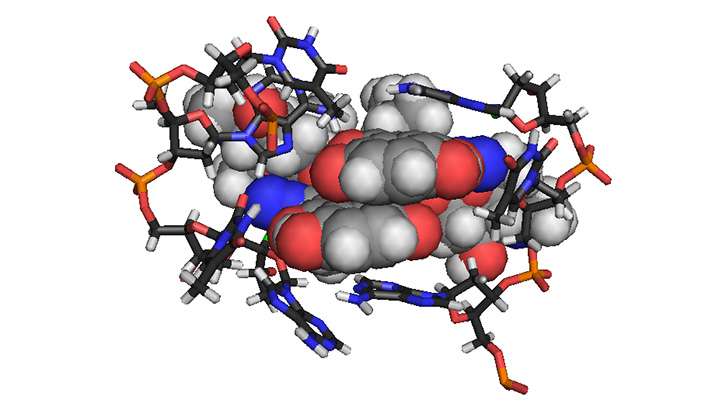Understanding the cancer-killing properties of a chemical commando

A Yale lab has unlocked the process by which a natural anti-cancer agent is able to bind to DNA and directly break both strands.
The discovery may be helpful in developing synthetic molecules for cancer therapies that can effectively disrupt the replication of DNA in diseased cells, say the researchers. The findings appeared online in the journal Proceedings of the National Academy of Sciences the week of Feb. 29.
"DNA is the canonical target for cancer treatment," said Seth Herzon, a chemistry professor at Yale and corresponding author of the study. "Because tumor cells are proliferating, they need to replicate their DNA more rapidly than healthy cells."
For nearly a decade, Herzon's lab has investigated certain chemical properties of lomaiviticin A, a natural byproduct of marine bacteria found on coral reefs. Lomaiviticin A has been shown to be effective in cleaving both strands of the DNA structure—to form what are known as double-strand breaks—but until now, scientists did not understand the process.
"A lot of compounds are able to damage DNA, but relatively few induce double-strand breaks directly. These are the most lethal type of lesions to the tumor cell," Herzon explained.
Using sophisticated, computational modeling, plus nuclear magnetic resonance spectroscopy, the researchers were able to find the key: proximity. Lomaiviticin A has the ability to bind with DNA in such a way that it places two essential reactive parts of the molecule in close proximity to each DNA strand.
"Lomaiviticin is like a chemical Navy SEAL," Herzon said. "It has been bred to shred DNA. Now that we understand its capabilities and how it works, we want to harness its awesome power for therapeutic purposes. We also need to keep it from wandering off and causing trouble, and make sure it carries out its operations with precision and efficiency."
The study's first author is Christina Woo, a former member of Herzon's lab who is now a postdoctoral fellow at Stanford. Co-authors are Zhenwu Li, a former Yale postdoc who is now at Incyte Pharmaceuticals; and Eric Paulson, NMR manager in Yale's Department of Chemistry.
More information: Christina M. Woo et al. Structural basis for DNA cleavage by the potent antiproliferative agent (–)-lomaiviticin A, Proceedings of the National Academy of Sciences (2016). DOI: 10.1073/pnas.1519846113
Journal information: Proceedings of the National Academy of Sciences
Provided by Yale University




















